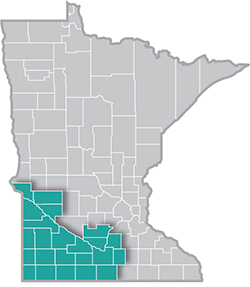 Southwest Minnesota is a national leader in agricultural production, and renewable energy.
Southwest Minnesota is a national leader in agricultural production, and renewable energy.
The region's thriving manufacturing sector includes food processing, machinery, printing, metal products, and computers and electronic products.
Want the freshest data delivered by email? Subscribe to our regional newsletters.
1/22/2018 10:09:32 AM
Luke Greiner
After experiencing a loss of 3,941 people since 2010, Southwest Minnesota is now home to 391,702 residents. Though the 23-county planning region enjoyed a natural increase – more births than deaths – of 5,410 people, Southwest Minnesota suffered an out-migration of 12,330 people who left to live elsewhere. Lost in the shadow of that outflow, however, was the region's international net in-migration of 2,993 new foreign-born Minnesotans, which helped offset some domestic losses.

Southwest Minnesota is now home to 17,628 foreign-born residents, or about 4.5 percent of the total population, according to the U.S. Census Bureau's American Community Survey. The number of immigrants in the region increased by 22.1 percent from 2010 to 2016, outpacing the statewide growth rate of 16.3 percent.
Over half (8,951 people) of these immigrants were from Latin America, including 5,181 people from Mexico. Already the largest immigrant group, the region gained 1,456 additional residents from Latin America between 2010 and 2016, a 19.4 percent gain.
The second largest number of foreign-born residents in the region were from Asia, accounting for one in every four immigrants. Most of these immigrants (2,582 people) came from Southeast Asia, which included more than 950 people from Laos and about 580 people from Thailand; and 975 people were from Eastern Asia, including China and Korea.
The fastest-growing wave of new immigrants to Southwest Minnesota came from Africa, rising by just over 1,000 people from 2010 to 2016, a 74 percent jump, pushing the region's African population to 2,366 people. The largest contingent is from Eastern Africa, primarily Somalia, which eclipsed 1,725 people in 2016 after rising nearly 145 percent since 2010.
Another 1,364 foreign-born residents were from Europe, which was actually a slight decline compared to 2010. Southwest Minnesota also saw a drop in the number of immigrants from Canada from 2010 to 2016, now comprising just 331 people.
Not surprisingly, immigrants have a much younger age profile than the native-born population in the region. In 2016, about 60 percent of the foreign-born population were in their prime working years between 25 and 54 years of age, compared to just 35.3 percent of the total population. Almost one in every four (23.5 percent) immigrants in the region was between 25 and 34 years of age, nearly double the share in the region's total population. In contrast, less than six percent of the region's foreign-born population was 65 years and over, compared to 17.7 percent of the total population.
Statewide, 72.1 percent of the foreign-born population aged 16 years and over was actively participating in the labor force, which was actually higher than the native-born population (69.6 percent). In Southwest Minnesota, that would equal just over 11,300 available immigrant workers, comprising about five percent of the region's workforce.
After averaging a net gain of just under 2,400 additional labor force participants per year between 1990 and 2001, Southwest Minnesota employers were able to tap into a large and growing pool of talented workers. However, from 2001 to 2016, Southwest Minnesota's labor force began to shrink, losing almost 2,750 workers. The region peaked with 225,616 available workers in 2009, but dropped to 221,526 workers in 2016.

In the face of increasingly tight labor markets, a growing scarcity of workers is now one of Southwest Minnesota's most significant barriers to sustained economic growth. It has become evident that immigration has been and will continue to be a vital source of the workforce that employers need to succeed. Immigrants have become critical to Southwest Minnesota's economy, providing a rapid stream of new workers in the face of an aging native-born workforce. While the region's overall labor force was shrinking, the number of immigrant workers in the region would have increased by nearly 2,050 workers from 2010 to 2016.
To read the full report on the importance of immigration in Southwest Minnesota and the rest of the state, visit our website.
Contact Luke Greiner at 320-308-5378 or Mark Schultz.